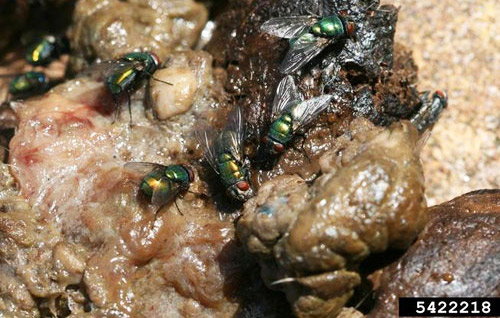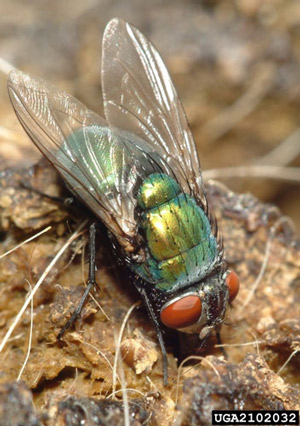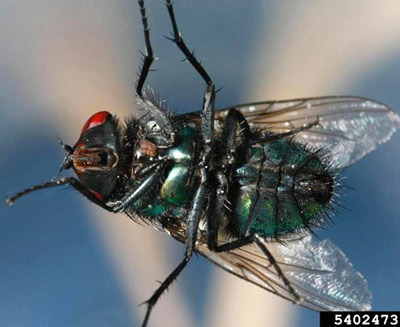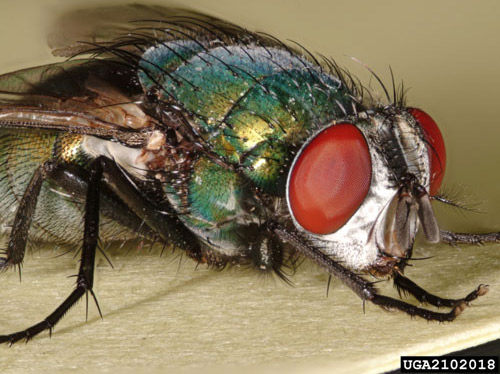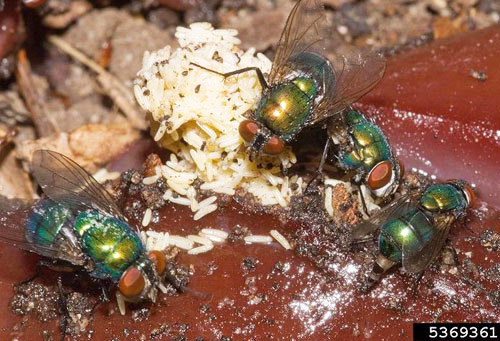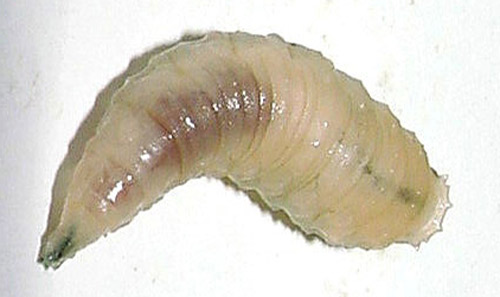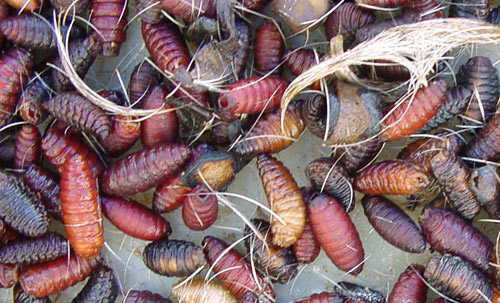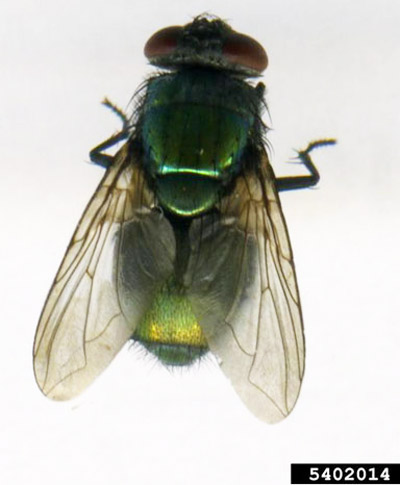common name: common green bottle fly, sheep blow fly
scientific name: Lucilia sericata (Meigen) (Insecta: Diptera: Calliphoridae)
Introduction - Synonymy - Distribution - Description - Life Cycle - Forensic Importance - Medical and Veterinary Importance - Selected References
Introduction (Back to Top)
The common green bottle fly, Lucilia sericata (Meigen), formerly Phaenicia sericata, is a common visitor to carrion, feces, and garbage. Lucilia sericata, is also one of the most common species in the genus (Whitworth 2006). This blow fly is a member of the family Calliphoridae, and like many of the other blow flies, L. sericata plays an important role in forensic, medical and veterinary science. In forensic science, the larvae or maggots help to determine the period of insect colonization as it relates to the time of death, aiding law enforcement in their investigations. Medical treatment using maggot therapy can help to heal infections that are otherwise incurable (Rueda et al. 2010). In the field of veterinary medicine, feeding by larval L. sericata can cause substantial losses in animals and production (Strikewise 2007).
Figure 1. Common green bottle flies, Lucilia sericata (Meigen), on dog feces. Photograph by Whitney Crenshaw, Colorado State University, Bugwood.org.
Synonymy (Back to Top)
Lucilia sericata (Meigen)
Lucilia barberi Townsend, 1908
Lucilia giraulti Townsend, 1908
Lucilia sayi Jaennicke, 1867
Musca sericata Meigen, 1826
Phaenicia sericata Meigen, 1826
(Whitworth 2006, ITIS 2011)
Distribution (Back to Top)
Lucilia sericata is found throughout the world, but is more specifically described as having a Holarctic (Northern Hemisphere) distribution, being widely distributed throughout the United States and southern Canada. Despite being mostly Holarctic, L. sericata is now found commonly in Australia and in several South and Central American countries (Rueda et al. 2010). According to the Australian Museum (2009), the sheep blow fly is more coastally distributed and prefers moister climates in that country.
Description (Back to Top)
Adults: The adults are usually a metallic green and can also have a copper green color. The mouthparts are usually yellow (Apperson et al. 2011). The back is hairy and the overall diameter is about 8–10 mm. The squamae at the base of the wings are hairless (Salimi et al. 2010).
Figure 2. Dorsal view of the common green bottle fly, Lucilia sericata (Meigen). Photograph by Joseph Berger, Bugwood.org.
Figure 3. Ventral view of the common green bottle fly, Lucilia sericata (Meigen). Photograph by Joseph Berger, Bugwood.org
Figure 4. Anterior-lateral view of the common green bottle fly, Lucilia sericata (Meigen). Photograph by Joseph Berger, Bugwood.org.
Eggs: The eggs of L. sericata are usually white, but can be a pale yellow. They are often deposited in batches or masses. The eggs are elongated with one end tapered slightly, and are approximately 1.5 mm long (Apperson et al. 2011).
Figure 5. Adult female common green bottle flies, Lucilia sericata (Meigen), laying eggs. Note the extended ovipositor on adult in lower right corner. Photograph by Susan Ellis, Bugwood.org.
Larvae: All stages of the larvae are smooth (Australian Museum 2009). They are conical-shaped and have a complete peritreme (area surrounding the spiracles) on their posterior spiracles (structures, which look similar to eyes, on the rear of the larvae that are used for respiration) (Salimi et al. 2010). The larvae are white or yellowish through all three instars of development and reach a maximum of 12–18 mm before pupation (Apperson et al. 2011). Identification of immature blow flies is difficult, requiring a microscope, and identifications are often confirmed by rearing these immatures to the adult stage.
Figure 6. Late instar larva of a Lucilia species. Head at bottom of image. Photograph by Richard Major, © Australian Museum. Used with permission.
Pupae: The pupae are enclosed in a hardened shell that is usually reddish brown, light brown or black in color. This shell is comprised of the last larval instar skin. They are 9–10 mm long with a width ranging from 3 to 4 mm (Apperson et al. 2011). Initially, the pupal case is white but rapidly darkens in a matter of hours.
Figure 7. Pupae of a Lucilia species. Photograph by Richard Major, © Australian Museum. Used with permission.
Life Cycle (Back to Top)
At approximately 21°C, L. sericata eggs take about 21 hours to hatch, and at 27°C it takes about 18 hours to hatch, following their deposition. Larval development requires approximately four days at 20°C and three days at 27°C. There are three instars through which the larvae develop (Anderson 2000). However, many other factors play a role in development, including the food source and humidity (Tarone et al. 2006). Once fully developed, the 3rd instar larvae leave the host or carrion and burrow into the soil or substrate surrounding it (Strikewise 2007). Pupal development takes approximately 10 days at 21°C and seven days at 27°C (Anderson 2000), after which the adult fly emerges. After mating, adult females lay clusters of up to 200 eggs at a time, on the host or carcass. There can be multiple generations per year (Strikewise 2007).
Forensic Importance (Back to Top)
Lucilia sericata is very important in the field of forensic science. The immature flies are used to estimate the minimum portion of the post-mortem interval, known as PMI, in a multitude of settings (Rueda et al. 2010). According to The Australian Museum (2009), L. sericata is one of the first insects to arrive at a corpse. Byrd and Castner (2009) go further and state that calliphorids have appeared on carcasses in experiments within minutes of death. They also state that calliphorids, along with scarophagids (flesh flies) and muscids (filth flies) are the most important species in providing accurate PMI estimations. Lucilia sericata also has been shown to oviposit in cool nocturnal conditions, which are quite uncharacteristic to the normal daytime ovipositing behavior of it and other calliphorids (Catts and Goff 1992). This behavior is uncommon and there is a short period of time after sunset that necrophilous flies will oviposit, and it is thought to be dependent on the local presence of flies near a corpse and the availability of artificial lights illuminating the area (Baldridge et al. 2006).
The most common way of estimating PMI using dipteran larvae, such as L. sericata, is to determine the developmental stage the immature is in when collected. Although this method is usually accurate, it can vary, as many factors can determine the growth rate of a larva. Tarone and Foran (2010) have developed a method using gene expression that provides greater precision in age estimation resulting in a more accurate and precise minimum PMI estimation.
Medical and Veterinary Importance (Back to Top)
Lucilia sericata is a commonly used species in human wound treatment for injuries that conventional treatments fail to heal (Rueda et al. 2010). This practice is called maggot therapy and its use continues to increase. Under the guidance of a physician, L. sericata larvae are placed on a wound, the wound is then wrapped and the larvae feed on the necrotic (dead) tissue and bacteria that occur in an infected wound. Their activity in a wound increases the promotion of healthy tissue growth (Horobin et al. 2002). This is achieved by not only eating the decomposing tissue but also secreting and producing antimicrobial enzymes while in the wound. Most patients receiving maggot therapy treatment have no pain. Initially, contamination of wounds was a concern, but proper use of sterile maggots has eliminated any chance of maggot-transmitted microorganisms (Sherman et al. 2000).
Lucilia sericata and a similar species, Lucilia cuprina (Wiedemann), are known in Britain and Australia for causing sheep strike. As a result, L. sericata is sometimes called the sheep blow fly. Sheep strike, also known as blowfly strike, is a type of myiasis (invasion of living tissue by fly larvae) and usually is observed near the rear of the sheep where there is fecal matter and urine on the wool (Strikewise 2007, Australia Museum 2009). This condition is quite serious and untreated sheep die.
Figure 8. Adult Australian sheep blow fly, Lucilia cuprina (Wiedemann). Image taken in Australia. Photograph by Lesley Ingram, Bugwood.org.
Selected References (Back to Top)
- Anderson GS. 2000. Minimum and maximum development rates of some forensically important Callophoridae (Diptera). Journal of Forensic Science 45: 824-832.
- Apperson CS, Arends JJ, Baker JR, Carter CC, Payne CS. (2011). Blow flies. Insect and Related Pests of Man and Animals. http://ipm.ncsu.edu/ag369/notes/blow_flies.html (30 August 2011).
- Australian Museum. (November 2009). Decomposition: \fly life cycle and development times. http://australianmuseum.net.au/Decomposition-fly-life-cycles/ (30 August 2011).
- Baldridge RS, Wallace SG, Kirkpatrick R. 2006. Investigation of nocturnal oviposition by necrophilous flies in central Texas. Journal of Forensic Science. 51: 125-126.
- Byrd JH, Castner JL. 2009. Insects of forensic importance. In Byrd JH, Castner JL (Editors), Forensic Entomology: The Utility of Arthropods in Legal Investigations (2nd Edition). pp. 43-45. CRC Press, Boca Raton, FL. 688 pp.
- Catts EP, Goff ML. 1992. Forensic entomology in criminal investigations. Annual Review of Entomology. 37: 253-272.
- Horobin AJ, Pritchard DI, Shakesheff KM. 2002. How do larvae of Lucilia sericata initiate human wound healing? European Cells and Materials 4 (Supplement 2): 69.
- ITIS. (2011). Phaenicia sericata (Meigen, 1826). Integrated Taxonomic Information System. (30 August 2011).
- Rueda LC, Ortega LG, Segura NA, Acero VM, Bello F. 2010. Lucilia sericata strain from Colombia: Experimental colonization, life tables and evaluation of two artificial diets of the blowfly Lucilia sericata (Meigen) (Diptera: Calliphoridae), Bogota, Colombia strain. Biological Research. 43: 197-203.
- Salimi M, Goodarzi D, Karimfar MH, Edalat H. 2010. Human urogenital myiasis caused by Lucilia sericata (Diptera: Calliphoridae) and Wohlfahrtia magnifica (Diptera: Sarcophagidae) in Markazi Province of Iran. Iranian Journal Arthropod-Borne Disease 4: 72-76.
- Sherman RA, Hall MJR, Thomas S. 2000. Medicinal maggots: an ancient remedy for some contemporary afflictions. Annual Review of Entomology 45: 55-81.
- Strikewise. (2007). Blowfly strike. http://www.strikewise.com/blowfly.html (30 August 2011).
- Tarone AM, Foran DR. 2006. Components of developmental plasticity in a Michigan population of Lucilia sericata (Diptera: Calliphoridae). Journal of Medical Entomology 43: 1023-1033.
- Tarone AM, Foran DR. 2010. Gene expression during blow fly development: Improving the precision of age estimates in forensic entomology. Journal of Forensic Sciences 56: S112-S122.
- Whitworth T. 2006. Keys to the genera and species of blow flies (Diptera: Calliphoridae) of America north of Mexico. Proceedings of the Entomological Society of Washington 108: 689-725.
